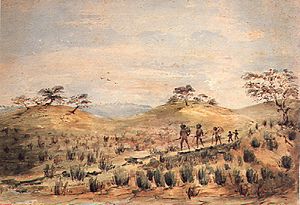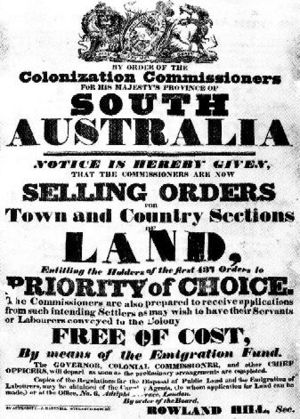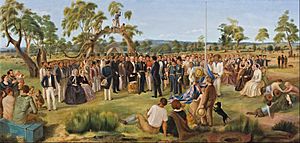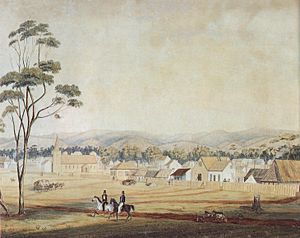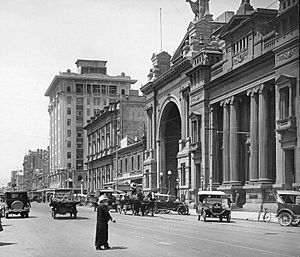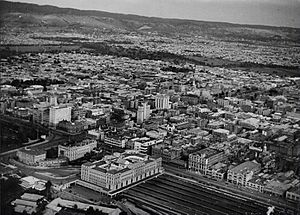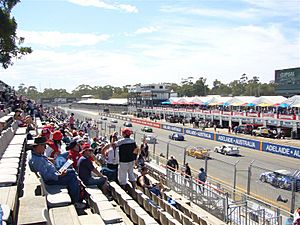History of Adelaide facts for kids

Adelaide is a carefully planned city in South Australia. It was founded in 1836 and became the capital of the state. This article explores Adelaide's history, from its first people to the 20th century.
Contents
First People of Adelaide
The land where Adelaide now stands was home to the Kaurna people for thousands of years before Europeans arrived. Their territory stretched from Cape Jervis to Port Broughton.
The Kaurna lived in family groups called yerta. This word also described the land that supported each family. Kaurna adults were responsible for their yerta, knowing all about its resources. They moved around within their yerta in large family groups, usually about 30 people.
The area of today's Adelaide city centre was called "Tarndanya" by the Kaurna. This means "male red kangaroo rock" and referred to a spot near the River Torrens. Before European settlers arrived, the Kaurna population was greatly reduced by at least two serious outbreaks of smallpox. These diseases traveled down the Murray River. When Europeans came in 1836, there were likely between 300 and 1000 Kaurna people left.
Britain Prepares for a New Colony
In the early 1800s, British and French explorers mapped the southern coast of Australia. In 1802, British Commander Matthew Flinders named Mount Lofty, but didn't explore the area where Adelaide is now.
Later, in 1830, Charles Sturt explored the Murray River. He was very impressed with the land near the Gulf St Vincent, calling it "a country of more promising aspect."
In 1831, Captain Collet Barker explored the area more closely. He found the land to be very rich and good for farming. Sadly, Barker was killed by local people near the Murray Mouth. Despite this, his detailed survey made Sturt believe that a perfect spot had been found for a new colony.
Edward Wakefield's New Idea
A group in Britain, led by Edward Gibbon Wakefield, wanted to start a colony without using convict labor. Previous Australian colonies had problems because land was given away for free. Wakefield suggested a new, more organized way to set up a colony.
In 1829, Wakefield wrote letters from prison about his idea of "systematic colonization." He proposed that land should be sold, not given away. The money from land sales would then be used to pay for skilled workers to travel to the colony for free. This way, the colony would have responsible workers, not just poor people or convicts. He also thought land prices should be high enough so that workers would stay in their jobs long enough before they could afford to buy land themselves. This would prevent a shortage of workers.
Forming the South Australian Association
Robert Gouger, Wakefield's assistant, promoted these ideas. In 1834, the South Australian Association was formed. With help from important people like the Duke of Wellington, they convinced the British Parliament to pass the South Australia Act 1834. This law allowed the new colony to be created.
Wakefield wanted the capital city to be named Wellington. However, King William IV decided to name it after his wife, Adelaide of Saxe-Meiningen. The British government chose a Board of Commissioners to organize the new colony. They had to sell at least £3,500 worth of land before anyone even arrived. Land was advertised, and people bought land orders in advance.
Suitable workers, usually healthy men and women under 30, were given free passage. They were expected to work for wages for a few years until they saved enough to buy their own land. To encourage land sales, buyers received one acre of town land in Adelaide for every 80 acres of rural land they bought. The biggest land buyer was the South Australia Company, which helped the colony get started.
Once the conditions were met, King William IV signed the official papers. The first settlers and officials set sail in early 1836.
British Settlement Begins (1836)
In February 1836, the first ships, John Pirie and Duke of York, sailed for South Australia. More ships followed, carrying supplies and settlers. Many settlers first went to Kangaroo Island to wait for the official decision on where the new colony would be. Governor John Hindmarsh arrived on the ship HMS Buffalo later that year.
The Surveyor-General, Colonel William Light, had only two months to find the best spot for the new settlement. He looked for a good harbor, fertile land, fresh water, easy transport, building materials, and good drainage. Light rejected places like Kangaroo Island and Port Lincoln.
Most settlers moved from Kangaroo Island to Holdfast Bay. Governor Hindmarsh arrived there on December 28, 1836. He officially announced the start of the new colonial government in South Australia.
Light had to work fast because settlers were eager to claim their land. He found the salt water Port River to be a good harbor, but there was no fresh water nearby. He then discovered the River Torrens and decided this was the best place for the city.
Light preferred a spot on higher ground along the Torrens valley, away from floods. Governor Hindmarsh first agreed but then changed his mind, wanting the city closer to the harbor. Other colonists thought different sites were better. After much debate, a public meeting was held on February 10, 1837. A vote was taken, and Light's choice won, with 218 votes to 127.
The city survey was finished on March 11, 1837. This was a great achievement, as similar surveys took much longer. Light's plan fit the land perfectly. The Torrens Valley was kept as parklands. Town areas were planned on higher ground to the north and south. Adelaide was divided into two parts: North Adelaide (342 acres) and South Adelaide (700 acres). These were surrounded by over 2,332 acres of parklands for public use.
The streets of South Adelaide were laid out in a grid pattern. It included a main square (Victoria Square) and four smaller squares (Hindmarsh, Hurtle, Light, and Whitmore). North Adelaide has Wellington Square. Spaces for public buildings like Government House, hospitals, and gardens were also included within the Park Lands.
Adelaide's Early Years
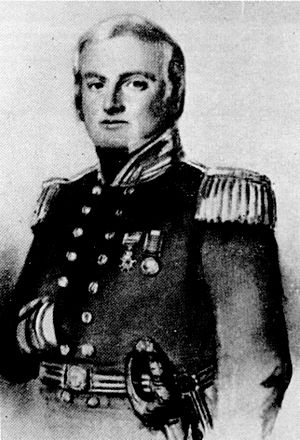
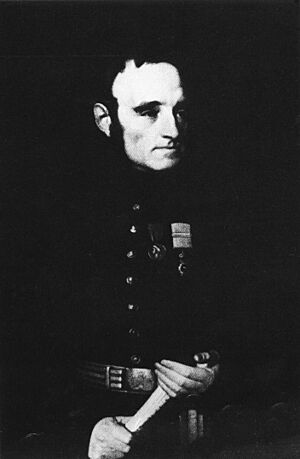

Governor Hindmarsh's Time
On March 23, 1837, colonists who had bought land before arriving got to choose their plots first. The remaining land was sold at auction. Within weeks, some areas were selling for much higher prices, which was seen as a good sign for the colony.
After the city was surveyed, Light's team had to survey a huge amount of rural land. Light's deputy, George Strickland Kingston, went to London in October 1837 to ask for more staff and equipment. He also wanted Governor Hindmarsh to be replaced. Light, who was ill with tuberculosis, managed to survey 243 square kilometers by December 1837. By then, the population had grown to about 2,500 people.
Light's requests were denied. He resigned in protest. Hindmarsh was replaced and left Adelaide in July 1838. The next governor, George Gawler, arrived in October 1838.
The first sheep and other farm animals in South Australia came from Tasmania. From 1838, sheep were brought overland from New South Wales. The wool industry became the main part of South Australia's economy for the first few years. Large areas of land were leased by "Squatters" for grazing. When the land was surveyed and put up for sale, these Squatters had to buy their land or move. Most bought their land, which made it hard for farmers to find good, empty land.
Farms took longer and were more expensive to set up than sheep runs. But by 1860, wheat farms stretched from Encounter Bay in the south to the Clare Valley in the north.
The city was meant to grow around Victoria Square, with wide streets like Grote and King William Streets. However, development happened mostly on the narrower Rundle and Hindley Streets. This was because they were close to the city's water supply and Port Road, which led to the port. Many city blocks remained empty until the late 1800s.
Governor Gawler's Time
Adelaide's second Governor, Colonel George Gawler, arrived in October 1838. He found almost no public money, underpaid officials, and 4,000 immigrants living in temporary homes. He was allowed to spend up to £12,000 a year. London had given him the idea that the colony didn't need to be self-sufficient and could rely on government support.
Gawler's first goal was to speed up rural settlement and farming. He convinced Charles Sturt from New South Wales to become his surveyor-general. Gawler also hired more officials, started a police force, and explored the surrounding areas. Many public buildings were built, including a governor's house, a jail, police barracks, a hospital, and a customs house at Port Adelaide.
After 1839, the land boom slowed down. Money and credit were hard to get. Explorations showed there was limited good land, and British investors became interested in New Zealand. In 1840, crops failed in other Australian colonies, which Adelaide still relied on for food. The cost of living quickly went up. Gawler increased public spending to prevent the economy from collapsing. This led to the colony going bankrupt and later, changes to how it was run. Over £200,000 in bills had built up, and the land fund in London was empty.
The British Parliament approved a £155,000 loan to help the colony. Captain George Grey was sent to replace Gawler. Even though he was recalled, Governor Gawler had put Adelaide on a strong path. He made South Australia able to grow its own food, built important structures like the Adelaide Gaol, and brought back public trust.
Governor Grey's Time
Grey, who was 29, announced Gawler's recall himself on May 15, 1841. He cut public spending sharply, which made people dislike him, but Grey ignored them. Silver was found at Glen Osmond that same year. This discovery raised spirits and led to more finds in the Mount Lofty Ranges.
Copper was discovered near Kapunda in 1842. In 1845, even larger copper deposits were found at Burra. This brought great wealth to Adelaide shopkeepers who invested in the mine. With good harvests and growing agriculture, Adelaide began exporting meat, wool, wine, fruit, and wheat.
John Ridley invented a reaping machine in 1843. This invention changed farming methods across South Australia and the whole country. By 1843, 93 square kilometers of land were growing wheat, compared to only 0.08 square kilometers in 1838. By the end of the century, South Australia was known as the "granary of Australia." From a low point in 1842, when many houses were empty and people talked about leaving, Adelaide became a busy city by the time Grey left to govern New Zealand in 1845.
Adelaide in the Late 1800s
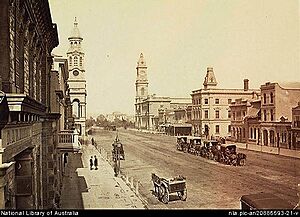
When gold discoveries happened in Victoria in 1851, many workers left Adelaide to seek their fortunes. This caused a big shortage of workers in South Australia. However, it also created a high demand for South Australian wheat. The situation improved when prospectors returned to Adelaide with their gold.
South Australians wanted to trade with Victoria and New South Wales, but land transport was too slow. In 1850, the South Australian government offered a £4,000 prize. It was for the first two people to travel the Murray River in a steamboat as far as the Darling River. In 1853, William Randell and Francis Cadell raced each other to Swan Hill. Cadell arrived first.
South Australia became a self-governing colony in 1856. A new constitution was approved by the British parliament. Secret ballots were introduced, and a parliament with two houses was elected on March 9, 1857. By this time, 109,917 people lived in the province.
In 1858, Robert Torrens created a new land title system. This system was copied in other Australian colonies and even overseas, like in Singapore. More copper was found in 1859 at Wallaroo and in 1861 at Moonta. In 1860, the Thorndon Park reservoir opened, giving Adelaide a clean water source instead of the muddy River Torrens.
During John McDouall Stuart's expedition in 1862, he found a huge area of grazing land in northern Australia. South Australia was then made responsible for managing the Northern Territory.
In 1867, gas street lighting was installed. The University of Adelaide was founded in 1874. The Art Gallery of South Australia opened in 1881, and the Happy Valley Reservoir opened in 1896.
In the 1890s, Australia faced a severe economic depression. This ended a time of rapid land sales and growth. Banks in Melbourne and Sydney closed. The number of births fell, and immigration almost stopped. The value of South Australia's exports nearly halved. Drought and poor harvests from 1884 made things worse, and some families moved to Western Australia. Adelaide was not hit as hard as Sydney and Melbourne. Discoveries of silver and lead at Broken Hill helped a little.
The government only had one year of financial deficit, but this meant job cuts and very careful public spending. Only the wine and copper industries did not suffer a downturn.
Adelaide in the 1900s
Historian F.W. Crowley noted what visitors said about Adelaide in the early 1900s: "Many visitors to Adelaide admired the smart planning of its founders. But they didn't like its strict, serious mood. Others thought it had the best and worst parts of Australian city life. This included very rich people living in fancy suburbs, while others lived in terrible poverty in industrial areas. People claimed to be Christian on Sundays, but were very focused on making money during the week."
Electric street lighting was introduced in 1900. Adelaide's electric tram service started in 1909.
During World War I, 28,000 South Australians volunteered to fight. After the war, Adelaide had a good period of growth. But with new droughts, it entered the Great Depression in the 1930s. The city later became prosperous again with strong government leadership.
In 1928, 2000 special police officers were brought in to stop a strike by dock workers. These volunteer "Citizen's Defence Brigade" members were armed and housed in a camp.
New industries helped the state rely less on farming. The 1933 census showed the state's population was 580,949. This was a smaller increase than other states due to South Australia's economic challenges.
In 1935, Goldsbrough Mort and Company built their large building on North Terrace.
World War II brought more industry and variety to Adelaide, thanks to the leadership of Thomas Playford IV. 70,000 men and women joined the war effort. Shipbuilding grew in Whyalla. Adelaide changed from a farming service center to a modern 20th-century city.
After World War II
After the war, a program helped 215,000 people from many European countries move to South Australia between 1947 and 1973. Electrical goods were made in old munitions factories. Holden cars were manufactured from 1948. An earthquake caused a lot of damage in March 1954. The Mannum–Adelaide pipeline brought River Murray water to Adelaide in 1955. Adelaide Airport opened at West Beach in 1955. Adelaide got a second university, Flinders University, in 1966.
In 1968, a plan for building a system of freeways across Adelaide was released. This was called the Metropolitan Adelaide Transport Study (MATS). However, people were against it. They worried freeways would cause traffic jams and other city problems. The Labor government, led by Don Dunstan, put the MATS plan aside. But they kept the land in case public opinion changed. In 1980, the Liberal party won government. Premier David Tonkin believed Adelaide's roads were good enough. He decided to sell off the land bought for the MATS plan. This made it impossible to build most of the planned freeways later, even if people changed their minds.
The Dunstan Government in the 1970s brought a "cultural revival" to Adelaide. They made many social changes and helped the city become a center for the arts. Adelaide hosted the Australian Grand Prix from 1985 to 1996. This car race took place on a street circuit in the city's east parklands. It later moved to Melbourne in a controversial decision. The (Old) Adelaide Gaol closed in 1988.
In 1989, the Australian Submarine Corporation naval shipyards opened.
In 1991, the University of South Australia was formed by combining several state government education institutions. In 1992, the State Bank collapsed. This caused a serious economic downturn for both Adelaide and South Australia.
Adelaide in the 2000s
In recent years, the Clipsal 500 V8 Supercar race has used part of the old Formula One circuit. The late 2000s saw the tram network extended. This was the first growth for the tram system after it had shrunk in the 1950s.
Images for kids


